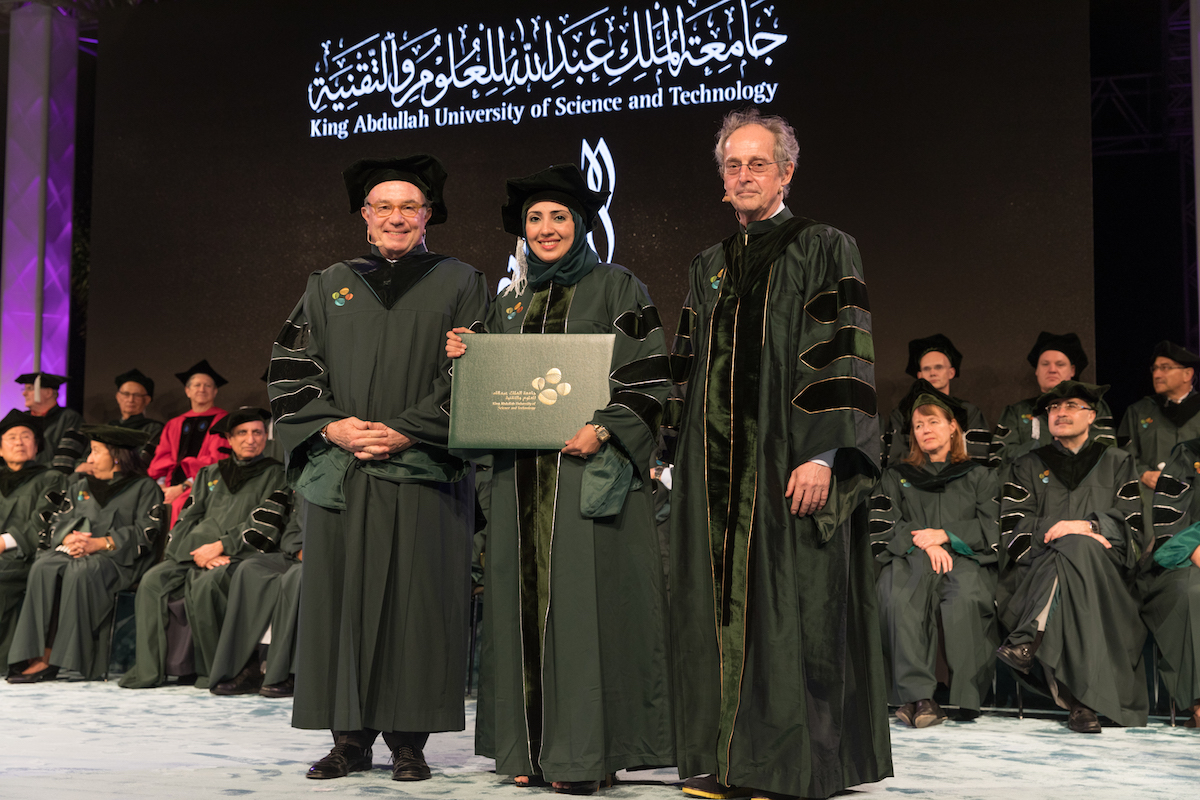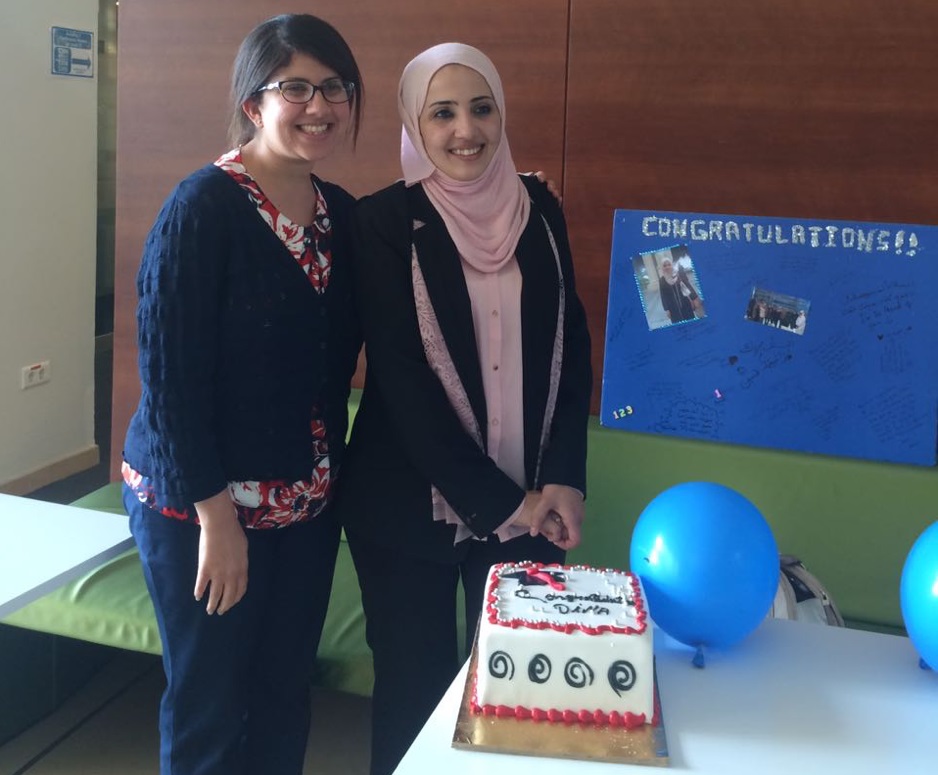Alumni Focus: Dina Bashir Abusamra

KAUST alumna Dina Bashir Abusamra (center) received her master's degree and Ph.D. from the University in 2010 and 2016, respectively. She is pictured here during the University's Commencement ceremony on December 16, 2016. Photo by Helmy Alsagaff.
-By David Murphy, KAUST News
KAUST alumna Dina Bashir Abusamra is a postdoctoral research fellow at the Schepens Eye Research Institute of Massachusetts Eye and Ear in Boston, Massachusetts, U.S. The Institute is an affiliate of Harvard Medical School and is one of the largest eye research and training institutes in the U.S.
Abusamra's academic journey began at King Abdulaziz University in Jeddah, where she obtained her bachelor's degree in biochemistry in 2009. Thanks to an outstanding GPA score of 3.99/4 at graduation, she had her choice of universities in which to continue her research career.
"At that time, KAUST was establishing itself and interviewing for students, and I was accepted in the second cycle of...students," she said. "I started my biological engineering master's [degree] during the summer of 2009 [and] then graduated in December 2010. I then pursued my Ph.D. in bioscience with [KAUST] Professor Jasmeen Merzaban in January 2011, earn[ing] my Ph.D. diploma in December 2016."
"Being a founder student at KAUST was not an easy journey, and it had its pros and cons. As a founder student, I was among the first students [in] Professor Merzaban's lab, [and] we had the privilege of helping her set up the lab," she continued. "This experience shaped my 'researcher voice.' It helped to hone the thinking and troubleshooting abilities necessary for life as a postdoctoral research fellow...[B]ack then, I complained about the workload, as it was not an easy task—it demanded full diligence and dedication on my behalf."

Alumna Dina Abusamra (right) celebrates with her supervisor, KAUST Associate Professor Jasmeen Merzaban (left), after her Ph.D. defense in 2016. Image courtesy of Dina Abusamra.
A move from the Kingdom to the U.S.
Abusamra was born and raised in Saudi Arabia, and her move to Boston marked the first time she left her home, family and comfort zone.
"Being at KAUST isolates you from the noise...of real life, so you are wholly focused on science and learning," she noted. "The transition to becoming fully independent with new duties in a new field was not an easy [or] a pleasurable journey at the beginning. However, with [Harvard Medical School Associate] Professor Pablo Argueso's lab support, I survived."
Abusamra's early research focus at KAUST was dedicated to understanding and optimizing the mechanisms by which transplanted hematopoietic stem cells "used to home back to bone marrow," she explained.
This process is controlled by multiple signaling and adhesion molecules, with key players being the glycan-binding protein called selectin. After her initial research in this area, Abusamra began to study the role of glycan-binding protein and galectins in microenvironment modulation using corneal wound healing as a model.

The move from Saudi Arabia to Boston (pictured) to begin her postdoctoral fellowship was challenging for alumna Dina Abusamra, but it opened many new doors for her. Image courtesy of Shutterstock.
From initial challenging days to the cover of Science Signaling
After overcoming her early days at Schepens, Abusamra pressed on with her work. Her perseverance led to her recent primary authorship of a paper that made the cover of Science Signaling, entitled "Galectin-3 initiates epithelial-stromal paracrine signaling to shape the proteolytic microenvironment during corneal repair."
"I am blessed that a prestigious journal like Science Signaling recognized my hard work," she said. "In [the] paper, we describe a paracrine signaling pathway between epithelial cells and fibroblasts mediated by glycan-binding protein (galectin-3). In summary, we found that galectin-3 on the surface of corneal epithelial cells stimulated corneal fibroblasts to produce the inflammatory cytokine IL-1b, which then signaled back to the epithelial cells, causing them to produce MMP9, which is necessary for matrix remodeling."
"In essence, the interaction between galectin-3 and the fibroblasts 'tells' the cells that the basement membrane has been breached and to initiate appropriate repair responses," she continued. "Given that galectin-3 is involved in repair in various tissues, it is possible that a similar paracrine signaling network also operates in other tissues. The novelty of the paper lies in the identification of galectin-3 mediated paracrine signaling network that is critical not only for cornea repair but for both tissue repair and tumor metastasis."
KAUST—a 'vibrant' place
Abusamra's advice to current KAUST students is to invest in every moment of their time at the University. This includes attending as many career-boosting trainings, seminars, workshops and Enrichment Programs as possible.
"KAUST is a vibrant environment for collaborations that you need to take advantage of," she said. "It is the only place that you can meet colleagues from different cultures and backgrounds [who may]...become your lifelong best friends. KAUST is a genuinely successful educational institution—I would like to thank [the University] for the opportunities it created in my career."
"Dina will always have a special place in my heart, as she was the first Ph.D. student to graduate from my lab," noted Merzaban. "Beyond being one of the most hard-working students I have come across, Dina is intelligent and resilient. She always impressed me during her Ph.D. and continues to stun me with her accomplishments. I am so proud [of] her successes...while at KAUST and during her postdoctoral career at Harvard. I have no doubt that she will continue to prosper and earn limitless success."

